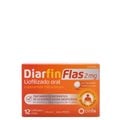Diarfin Flas 2 Mg 12 Oral Lyophilized
This medicine contains loperamide hydrochloride, which stops diarrhea by solidifying the stool and reducing the frequency of bowel movements. It is used to treat sudden, short-term (acute) attacks of diarrhea in adults and adolescents over 12 years of age. This medication should not be used for more than 2 days without medical assistance and monitoring.
This medicine contains loperamide hydrochloride, which stops diarrhea by solidifying the stool and reducing the frequency of bowel movements. It is used to treat sudden, short-term (acute) attacks of diarrhea in adults and adolescents over 12 years of age. This medication should not be used for more than 2 days without medical assistance and monitoring.
Diarfin Flas (2 Mg 12 Oral Lyophilized)
ACTION AND MECHANISM
- [ANTIDIARRHEAL], [OPIACE AGONIST (MU)]. Derived from pethidine. Agonist of μ-opioid receptors, which inhibits the release of acetylcholine and prostaglandins in the Auerbach myenteric plexus, reducing intestinal peristalsis. By reducing intestinal transit, it promotes the absorption of water and electrolytes, reducing the frequency and quantity of bowel movements, and increasing their viscosity. It also exerts a certain antisecretory effect. It also increases the tone of the anal sphincter, reducing incontinence.
PHARMACOKINETICS
- Absorption: It is absorbed in the intestine, presenting a bioavailability of 40%. It undergoes first pass metabolism. Cmax is reached after 5 hours (capsules) or 2.5 hours (solutions). Its effects last up to 24 hours.
- Distribution: Circulates bound to plasma proteins (97%). It crosses the blood-brain barrier with great difficulty.
- Metabolism: It is metabolized in the liver, giving rise to inactive metabolites.
- Elimination: It is eliminated by metabolism, with the metabolites being excreted with the feces (30% unchanged), and in a very small amount with the urine (<2%). Its elimination half-life is about 10 hours. The fraction of loperamide eliminated to the intestine can be reabsorbed, giving rise to an enterohepatic cycle.
Pharmacokinetics in special situations:
- Hepatic insufficiency: The metabolism of loperamide may be decreased in case of hepatic insufficiency, leading to a decrease in hepatic clearance.
INDICATIONS
- [DIARRHEA]. Symptomatic treatment of acute or chronic diarrheal processes.
POSOLOGY
- Adults, oral:
* Acute diarrhea: 4 mg (2 orodispersible tablets) will be administered as an initial dose, followed by 2 mg (1 orodispersible tablet) after each diarrheal stool up to a maximum of 16 mg/day (8 orodispersible tablets).
- Children, oral:
* Children over 12 years of age: 2 mg (1 orodispersible tablet) will be administered after each diarrheal stool.
In children, the maximum daily dose must be related to body weight (approximately 6 mg/20 kg): from 27 kg onwards, they may receive a maximum of 4 tablets; from 34 kg, 5 tablets; from 40 kg, 6 tablets; and from 47 kg, a maximum of 7 tablets.
DOSAGE IN KIDNEY FAILURE
No dose adjustment is required.
DOSAGE IN LIVER FAILURE
No specific dosage recommendations are available. Caution is advised as your first pass metabolism may be decreased.
RULES FOR CORRECT ADMINISTRATION
- Oral lyophilisates/orodispersible tablets: With dry hands, the blister should be torn through the scored section, without pressing the tablet. The aluminum foil will then be torn and removed from the blister. The lyophilisate/orodispersible tablet will be gently pushed out and placed on the tongue, allowing it to dissolve and ingesting it with saliva. It is not necessary to ingest it with water.
ADVICE TO THE PATIENT
- It is not advisable to start treatment with an antidiarrheal without consulting a doctor, since the antidiarrheal could worsen the symptoms.
- You should see a doctor if acute diarrhea persists or worsens after two days of treatment.
- You should consult your doctor if the stool is black, oily, foul-smelling, or if the presence of blood, mucus or pus is evident. You should also go to the doctor if a fever appears above 38 ºC in children or 38.5 ºC in adults, or if the patient presents abdominal pain that does not decrease with bowel movements.
CONTRAINDICATIONS
- [ALLERGY TO OPIOIDS] or to any component of the medication.
- Bloody diarrhea caused by invasive microorganisms such as enteroinvasive strains of Escherichia coli , Salmonella ([SALMONELOSIS]) or Shigella ([SHIGELOSIS]), or in the case of [PSEUDOMEMBRANOUS COLITIS], caused by broad-spectrum antibiotics. In these situations, the use of loperamide is not recommended, since by inhibiting peristalsis it could increase the contact time between the intestinal mucosa and microbial toxins, increasing the damage. In the case of bacterial diarrhea, it may sometimes be necessary to administer antibiotics.
- Situations in which you want to avoid inhibition of peristalsis, such as [CONSTIPATION], [INTESTINAL OBSTRUCTION] or [ABDOMINAL DISTENSION], since loperamide could aggravate the process. If any of these symptoms appear during diarrhea treatment, it is advisable to stop treatment.
PRECAUTIONS
- [LIVER FAILURE]. Loperamide is eliminated through the liver, so in case of insufficiency, first-pass metabolism could decrease, with consequent accumulation of the drug. It may be necessary to readjust the dosage depending on the degree of insufficiency.
- [ULCEROUS COLITIS] or [HIV INFECTION]. In patients with ulcerative colitis or AIDS, the administration of antidiarrheal drugs that inhibit intestinal motility has been associated with an increased incidence of toxic megacolon, so it is advisable to take extreme precautions and suspend treatment in the event that abdominal distension appears. or another symptom such as severe abdominal pain, nausea, vomiting, or loss of appetite.
- [DEHYDRATION]. Inhibition of intestinal peristalsis can lead to fluid retention in the intestinal lumen, aggravating dehydration. It is advisable to first correct the patient's dehydration by administering water or oral rehydration solutions.
PRECAUTIONS RELATING TO EXCIPIENTS
- This medicine contains sodium salts, which should be taken into account in patients on low-sodium diets.
- This medicine contains aspartame as an excipient. Aspartame contains a source of phenylalanine that can be harmful if you suffer from [PHENYLKETONURIA] (FCN), a rare genetic disease in which phenylalanine accumulates because the body is not able to eliminate it properly. 10 mg of aspartame equivalent to 5.61 mg of phenylalanine.
SPECIAL WARNINGS
- The administration of loperamide to patients with diarrhea does not exclude adequate hydration of the patient, so it is advisable to administer liquids such as water, infusions or oral rehydration solutions in the necessary quantities. Symptoms such as thirst, dry mouth and skin or decreased urine volume are clear signs of dehydration.
- It is not advisable to administer loperamide to dehydrated patients before correcting dehydration
INTERACTIONS
- Cholestyramine. A possible inhibition of the effect of loperamide has been recorded in one study, so spacing administration is recommended.
- Laxatives: The administration of antidiarrheals such as loperamide with intestinal bolus-increasing laxatives such as ispagula, methylcellulose, agar or sterculia gum is not recommended, because simultaneous use can cause intestinal obstructions with serious results for patients.
- Ritonavir or quinidine (P-glycoprotein inhibitors): possible increase in loperamide Cp. Caution.
- CYP3A4 (e.g. ketoconazole or itraconazole) and CYP2C8 (gemfibrozil) inhibitors: possible increase in loperamide Cp. Caution.
- Saquinavir: Possible reduction of saquinavir Cp with risk of decreased antiviral activity.
- Theophylline. In pharmacokinetic studies, a decrease in theophylline absorption has been observed when administered in controlled release forms, probably due to inhibition of intestinal motility.
- Opioid analgesics. Their simultaneous use may increase the risk of severe constipation and CNS depression.
PREGNANCY
Safety in animals: in animal studies using doses 30 times higher than human doses, there was no evidence of harm to the fetus. Higher doses alternated maternal and neonatal survival.
Safety in humans: There are no adequate and well-controlled studies in humans. Its administration is only accepted if there are no safer therapeutic alternatives, and the benefits outweigh the possible risks.
Effects on fertility: no specific studies have been performed in humans.
LACTATION
Safety in animals: no data available.
Safety in Humans: Data on the excretion of loperamide in breast milk are limited. Small amounts of loperamide have been detected in milk, so its use during breast-feeding is not recommended.
CHILDREN
It should not be administered to children under 12 years of age without prescription and medical supervision.
ADVANCED AGE
No specific problems have been described in the elderly that require dosage readjustment.
Dehydration associated with diarrhea is especially common in the elderly, so there may be great variability in its effects.
ADVERSE REACTIONS
Adverse effects of loperamide are, in general, infrequent although moderately important. In most cases, adverse reactions are a prolongation of the pharmacological action and mainly affect the digestive system, being in most cases indistinguishable from the symptoms of diarrhea itself. These adverse reactions are more common in long-term treatments. The most characteristic adverse reactions are:
- Digestives. In very rare cases (<0.01%) the appearance of [ABDOMINAL PAIN], [FLATULENCE], [DYSPEPSIA], [NAUSEA], [VOMITING], [CONSTIPATION], [DRY MOUTH], [ABDOMINAL DISTENSION], [PARALYTIC ILEUS ] or [TOXIC MEGACOLON].
- Neurological/psychological. The presence of [DUSKY] and [DIZZY] is rare (<0.01%). Children are especially sensitive to the nervous effects of loperamide.
- Genitourinary. On specific occasions [URINARY RETENTION] may appear.
- Allergic/dermatological. They are very rare (<0.01%) [EXANTEMATIC ERUPTIONS], [URTICARIA] or [PRURITUS]. Isolated cases of [ANGIOEDEMA], [STEVENS-JOHNSON SYNDROME], [ERYTHEMA MULTIFORME] and [TOXIC EPIDERMICAL NECROLYSIS] have been reported, although their relationship with loperamide has not been evaluated.
Isolated cases of [HYPERSENSITIVITY REACTIONS], including [ANAPHYLAXIA], have also been described.
OVERDOSE
Symptoms: In case of overdose, depression of the central nervous system may occur, with stupor, drowsiness, miosis, muscle hypertonia and respiratory depression. Urinary retention or ileal atony may also appear. This overdose occurs especially in cases of liver failure or in young children.
Treatment: The patient should be monitored for 48 hours to detect possible central nervous system depression. In the event that these symptoms appear, naloxone can be administered as an antidote. As the duration of effects of loperamide is longer than that of naloxone, which does not exceed three hours, naloxone administration may need to be repeated. Furthermore, it may be advisable to administer activated charcoal after ingesting loperamide in case of accidental ingestion, followed by gastric lavage if vomiting has not occurred.



